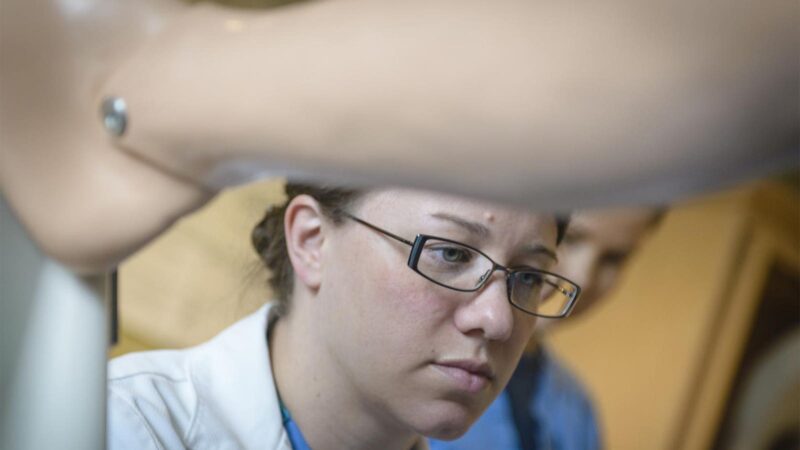California Offers a Lifeline for Medical Residents Who Can’t Find Abortion Training

Bria Peacock, MD, chose a career in medicine because the Black Georgia native saw the dire health needs in her community — including access to abortion care.
Her commitment to becoming a maternal healthcare provider was sparked early on when she witnessed the discrimination and judgment leveled against her older sister, who became a mother as a teen. When the Supreme Court overturned Roe v. Wade in 2022, Peacock was already in her residency program in California, and her thoughts turned back to women like her sister.
“I knew that the people — my people, my community back home — was going to be affected in a dramatic way, because they’re in the South and because they’re Black,” she said.
But even though Peacock attended the Medical College of Georgia, she’s doing her obstetrics and gynecology residency at the University of California San Francisco (UCSF), where she has gotten comprehensive training in abortion care.
“I knew as a trainee that’s what I needed,” said Peacock, who plans to return to her home state after her residency.
Ever since the Supreme Court decision, California has worked to become a sanctuary for people from states where abortion is restricted. In doing so, it joins 14 other states, including Colorado, New Mexico, and Massachusetts. Now, it’s addressing the fraught issue of abortion training for medical residents, which most doctors believe is crucial to comprehensive ob-gyn training.
A law enacted in September makes it easier for out-of-state trainees to get up to 90 days of in-person training under the supervision of a California-licensed doctor. The law eliminated the requirement for a training license and also permitted training at programs such as Planned Parenthood that are affiliated with accredited medical schools.
“By allowing physician residents to come to California, where there are more opportunities for abortion training, and by allowing them to be reimbursed for this work, we’re sending a message that abortion care is healthcare and an essential part of physician training,” said Lisa Folberg, CEO of the California Academy of Family Physicians, which supported the bill.
The question of how to provide complete ob-gyn training promises to become more urgent as the effects of abortion bans on medical education become clear: 18 states restrict or ban abortion to the point of effectively stripping 20% of ob-gyn medical residents of the opportunity to get abortion training, according to the Ryan Residency Training Program in Abortion and Family Planning. That’s 1,354 residents this year out of 5,962 ob-gyn residents nationwide.
The restrictions in some cases aim to reach beyond state borders, spooking medical students and residents who fear hostility from anti-abortion groups and right-wing legislators.
One ob-gyn resident in a state with abortion restrictions, who asked to remain anonymous for fear of reprisals, said she’s keen on getting comprehensive abortion care training in California — but can’t.
“My program will not allow us to perform abortions in other states,” she said.
She said administrators worry that doing so would subject residents to litigation because the program is state-funded.
“That is how my program is interpreting the law,” she said. “They’re being very conservative in order to protect us.”
Pamela Merritt, executive director of Medical Students for Choice, pointed to a Kansas law that requires repayment of state medical school scholarships — with 15% interest — if residents perform abortions or work in clinics that perform them, except in cases of rape, incest, or a medical emergency.
Doctors point out that abortion training is not just about ending pregnancies. Peacock recalled a patient who started hemorrhaging badly shortly after a healthy delivery. Peacock and her team at UCSF performed a dilation and curettage — a procedure commonly used to terminate pregnancy.
“If we did not have that skill set, and the patient continued to bleed, it could have been life-taking,” said Peacock, chief ob-gyn resident at UCSF.
It’s not yet clear how many spots will be available in California to train out-of-state medical residents as demand ratchets up. “Many sites were already at their training maximums and are unable to expand opportunities to others,” said Michael Belmonte, MD, a fellow with the American College of Obstetricians and Gynecologists.
Between June 2022, when Roe was overturned, and the end of June 2023, 125 out-of-state doctors did residencies in programs that use the Ryan Residency Training Program model, according to Kristin Simonson, director of programs and operations. Ryan helps ob-gyn residency programs integrate comprehensive abortion care training.
Even when opportunities to learn abortion care are available, those seeking training are proceeding with caution. “Residents arranging to travel for abortion training, like patients who travel for abortion care, are making arrangements quietly so they do not draw unwanted attention or repercussions,” said Janet Jacobson, MD, medical director and senior vice president of clinical services at Planned Parenthood of Orange and San Bernardino Counties, which just trained its first resident from a state with an abortion ban.
Statistics on harassment and attacks against abortion providers or disruption of their work back up such concerns, even in states where abortions are allowed. From 2021 to 2022, for example, there were upticks in stalking of personnel, bomb threats, assault and battery, and obstruction, according to the latest data from the National Abortion Federation.
Jessica Mecklosky, MD, a pediatric resident at UCSF, said she hopes to focus on adolescent medicine, including reproductive health, where she can offer young patients choices about their futures. Her medical school experience in Louisiana, she said, is a prime example of why abortion training in California and other states is so crucial.
She initially wanted to specialize in obstetrics and gynecology but switched to pediatrics, which also would involve reproductive healthcare. Although she knew Louisiana had abortion restrictions, she didn’t realize how much those restrictions would interfere with her ability to learn: There were just three abortion clinics in the entire state, and as she soon found out, none were available for her training.
“I was actually not going to be able to see any elective abortion procedures throughout medical school, because we don’t rotate through any abortion clinics,” she said. There was an opportunity for a day’s training in her third year, “but, unfortunately, Roe fell before I was able to do that.”
Through Medical Students for Choice, a group that provides stipends of up to $1,200, Mecklosky got an abortion care rotation at Montefiore Medical Center in New York during her summer break.
Mecklosky is torn about where she’ll land after her residency. She may return to Louisiana and advocate for legislative changes in reproductive health while attending to patients and making forays to other states to provide abortions.
She recounts an experience in New Orleans when the Dobbs v. Jackson Women’s Health Organization decision, which undid Roe, was imminent that is etched into her memory. “I had actually seen a few patients who were minors, were pregnant, and wanted to terminate their pregnancies,” she said, noting that they could not afford to travel for an abortion. “And I just remember having this sense of dread, just knowing that if we couldn’t get them into an appointment in the next 24 or 48 hours, it was possible that they would not be able to do it.”
Peacock, for her part, is adamant about returning to Georgia, where abortions are banned after 6 weeks. “I’m still going to provide abortions, whether that’s in Georgia or I need to fly to a different state and work in abortion clinics for a week out of the month,” she said. “It would definitely be a big part of my work.”
KFF Health News is a national newsroom that produces in-depth journalism about health issues and is one of the core operating programs at KFF — an independent source of health policy research, polling, and journalism. Learn more about KFF.








